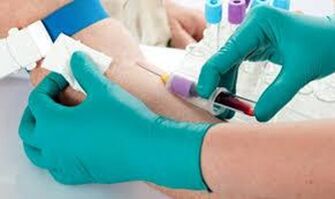Parasites living in the human body cause discomfort of unclear etiology.It may be rashes, flatulence, stomach burns, nausea, weakness, anemia, joint pain.To clarify the diagnosis, special tests must be carried out.
Parasites that can live in the human body

Classification of parasites in their appearance:
- Lamblia,
- Opistorchi,
- Echinococci,
- Toxockers,
- Trichinella,
- Askarids.
For representatives of certain professions (for staff of catering companies, children's institutions), an analysis of verse eggs is necessary in the design of health books.Children pass the same analysis to admission to children's gardens and a crèche or in a sports section.
- A classic study on worms living in the gastrointestinal tract is an analysis of the excrement and a scratch of the rectum mucosa.
- But there are several options for more effective blood tests for parasites, as expected and according to the method.
Classic research on verses
A classic study on worms living in the gastrointestinal tract (gastrointestinal tract), for example, pinworms, ascarids, is an analysis of the excrement and a scratch of the mucosa of the rectum.But an analysis in a time of excrement may not show positive results, so it is advisable to do three times.
- To analyze the excrement and scratching, the histological coprogrammed method is used (visualize the sections of the material under the microscope).Research efficiency is around 20%, because the probability is low that eggs or parasitic larvae fall into the analyzed material.
- Controversial studies for helminthes, simple parasites and fungi in the body are electro-acupuncture methods.Their essence is to obtain results using bioelectric reactions from active points with electrodes.To this end, special devices are used.Many doctors receive skeptical research data.
- The most informative examination of parasites is a blood test.
Types of blood tests for parasites
There are several options for blood tests for parasites: as expected and depending on the method.Each of these methods has its own advantages and disadvantages.According to the methodology used, the following types of blood tests exist:
- Elisa or immunophyphs of blood;
- PCR or chain reaction by polymerase;
- Hemoscan;
- Serological blood test.
Elisa, analysis of antibodies and immunoglobulina
This analysis is based on the immune response of the body, the level of its protection reaction to the invasion of parasites.When antibodies are formed in the form of the human body in response to the entry of a pathogen or simply a foreign protein into his blood, they are called immunoglobulins.
- Using the results of the ELISA, you can determine the presence of helminths in the body and their type.The precision of the study is much higher than the analysis of the excrement.
- The method is based on the calculation of antibodies in the body to one or the other type of parasites, the determination of their connection with foreign antigens (immune response) and the enzymatic reaction of the body.
- Antibodies - Antigens indicate the presence of an infection.
- One blood test by Elisa has a precision, according to different experts, from 60% to 90%, even at the low level of invasion.
- The advantage of the method, in addition to a high level of precision, is that an immuno-functioning analysis can be monitored by the dynamics of the disease over time.
IFA Blood Tests for parasites
An analysis of antibodies resembles a set of characters indicating these antibodies or they are called immunoglobulins.
- A total of 5 of them were studied - IGG, IGA, IGM, IGE IGD.
- In practical medicine, the first four immunoglobulins are important.
IGM is the main marker of the acute phase of the disease
IGM - Immunoglobulin, which appears in the acute phase of the disease, indicates the beginning of the infection.
- Appears in the blood on the fifth day,
- It is detected by analysis after 6 weeks.
- Then he begins to disappear quickly.
IgE - Marker, parasitic infection indicator
IGE - Immunoglobulin indicates the presence of parasites or allergies in the human body.
- is a marker of the processes associated with allergies,
- It circulates little in the blood, is based on mucous membranes, macrophages and basophils,
- Participate in immune responses in infection by parasites.
IGG - Marker of disease and immunity
IGG - Immunoglobulin, appears in the process of the disease.
- The IGG also preserved after a remedy, for certain life infections, for example, measles, rubella and others.
- The detection of immunoglobulins in the blood says that the body had already encountered this infection before, with this specific pathogen.
The result of the elete parss analysis
For different combinations of attot and inaugurations in the blood test for parasites, the following conclusions can be drawn:
- Lack of infection - All antibodies with less;
- Aigu-Igg (+/-), IGA (+\-), IgM (+);
- Chronic form-IGG (+/-), IGA (-), IgM (-);
- The presence of immunity-IGG (+), IGA (-), IgM (-);
- Exacerbation of a chronic disease - IGG (+), IGA (+), IGM (+)
- If the disease is detected and treated, the less values of all antibodies will not be obtained until six months after treatment, sometimes after 1 to 2 years.
The reliability of Elisa's analysis
The Elisa method gives the level of reliability of 90% for the diagnosis of infection by ascarids, pine worms (enrobiosis), toxocars and others which cause the formation of IgG immunoglobulin in large quantities.
- You can determine the lambliosis by separate and general value (OPD) of the level of antibodies in the blood.
- The value of the OPD is greater than 1 suggests that there is an infection or was,
- With a value less than 0.85, there is no Lamblia.
- If the value is in the meantime, it is advisable to repeat the analysis after 2 weeks.
This method is characterized by a number of weaknesses.The analysis allows you to determine the level of antibodies developed in the body for the neutralization of the Helminthes, and not the verse themselves.
- Therefore, it is possible to obtain false positive and false negative results.
- This also happens when patients take medication,
- Metabolic disorders and presence of parallels of current chronic diseases.
General blood test, changes in parasitic infection
You can indirectly suspect the presence of an invasion by performing a general blood test.Since the presence of worms affects the internal organs, the products of their vital activity enter the blood circulation, modifying its composition.Partial list of the results of the effect of the invasion on blood parameters:
- increase in hemoglobin;
- Non -normative indicators of ESR;
- excess of eosinophiles of 20%;
- Zhelezia anemia.
If there are no other reasons for such differences, it is advisable to include a special blood test for parasites, Elisa, PCR in the diagnostic program.
Polymerase chain reaction, PCR analysis
The PCR method, or chain reaction in polymer, is considered fundamental in molecular diagnostics and is one of the most modern and precise for the diagnosis for the presence of parasites in the body.
- It consists in detecting traces of DNA and RNA, belonging to parasitic life forms.
- The essence of the reaction of the polymerase is blood treatment so as to copy and propagate DNA, the RNA of organisms foreign to a concentration which allows them to determine.
Serological blood test
At the same time, the analysis is used as a source of information on blood serum.
- Immunogenic antibodies of parasites are studied.
- The analysis allows you to identify a large number of parasitic forms, but does not allow you to determine the stage of the invasion.
- Like the IFA method, serological analysis is indirect for diagnosis.
- If the OPD values are high, it is advisable to also pass the fecal analysis.
Diagnosis by blood sweeping method
During hemoscania on parasites, a drop of "living" blood of a patient is studied by optical devices in which, in addition to the worms, you can determine their larvae and fungi.
How to pass a blood test for parasites

The blood donation for parasites is made in a specialized laboratory.The blood for the analysis is removed from the vein of the elbow in quantity of 3 to 5 ml and is placed in a dry sterile test tube.Before passing the analysis, it is recommended:
- Do not eat for 8 hours;
- In the evening meal, abandon fat dishes and milk;
- Do not have alcohol and carbonated drinks;
- Avoid excessive physical effort, physiotherapy, X-ray radiotherapy;
- refuse to take medication.
- An abundant drink is welcome.
- Blood donation conditions to PCR are less strict, because the degree of satiety does not affect the presence of parasites.
Analysis dates
- The results of IFA and serological tests are published in a week.
- For PCR blood tests and the hemoscan, a few hours are enough.
- With the results of the analysis, you should certainly consult a doctor.
























